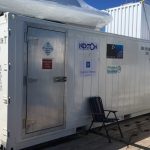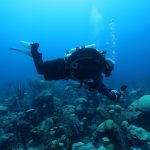Mission Day: Sixteen, Seventeen and Eighteen
 |
| The Baseline Explorer – 150 feet |
“What’s your motivation”? has been a common question that I am asked by the media on board. There are several motivations but for me, number one, is the opportunity to rebreather dive on deep ocean walls and execute incredible underwater mission plans with the absolute best divers in the world. Secondarily, providing the science samples for the great scientists that are on this ship and experiencing their appreciation and gratitude; our work is allowing them to work and be productive full time. As a team we are very proud of our work. I have included a couple images of some of the research being done aboard the BEx as a result of our dive missions; keep reading.
 |
| An actual algae sample pressed onto paper, catalogued and DNA tested |
 |
| Another pressed algae image – merging of art and science |
 |
| Coral specimen DNA analysis chart |
 |
| Pilot Kelvin (RT) and passenger: I took this image while interacting the submersible Nomad |
-> 3 August, we returned to Spittal and did another 2-mile dive from 300 feet / 90 meters into 20 feet / 6 meters. This was Sue’s last day with us. What an honor it was to dive with her again. A highly skilled underwater research diver and a joy to have as my surface support buddy whilst the Red team was under. We did 6 transects, collected 25 water samples, bagged 3 1-gallon Ziploc bags with algae and got about 20 pounds of coral samples. 339 feet / 104 meters (still have not reached GB 110) for 302 minutes…yep, 5 hours underwater.
 |
| A selfie of Sue and myself working the back deck…hardhats and closed shoes required |
-> 4 August, we supported the newly modified Red Team at the site North North East. Why “newly modified”? Because with Kevin and Graham gone, two new GUE divers from South Korea, Kyungsoo Kim (he likes to be called Jerry) and Su Eun Kim (Sue) streamed smoothly in to the 2 vacated positions and conducted 300 feet / 90 meter transects and collected several water samples.
That is it for this post. I will be back in about 3 days time. Weather is looking bad tomorrow, 7 August and worse for 8 August, but we will see if it keeps us divers on the surface! Thanks for tuning in…


 Previous Post
Previous Post Next Post
Next Post